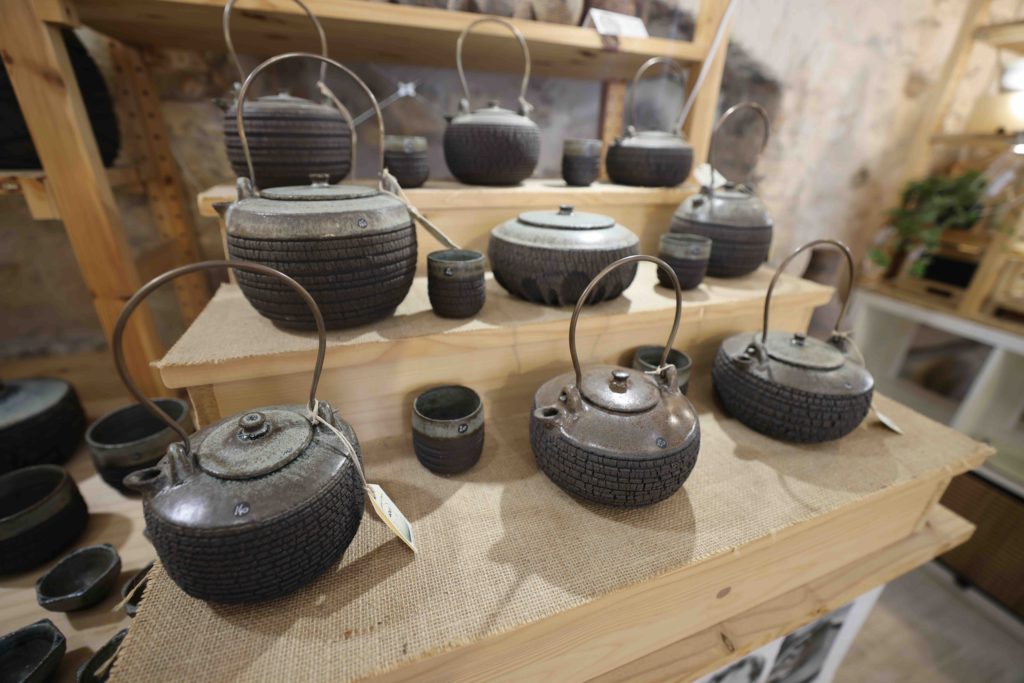Making Japenese pottery in southern France 🇫🇷
Where: Antibes, France 🇫🇷
It was the earthy coating on the bottom-halves of the pottery that caught my attention: The trim, earthen, almost like dried lava, gave the pottery an earthy yet modern look to them.

A collection of pottery that Mauric made and displayed for sale at his art boutique in Antibes, France. The pottery is made using a traditionally Japenese method called Terre Craquelée.
”With the fire, inside, and then crack.” Stephane Mauric explained to me after I inquired about his pottery collection for sale. I was in the old town of Antibes, France, for three nights. And then on my way next to Saint Tropez to learn to sail. I walked into Stephane’s boutique just outside of Port Vauban during an afternoon walk.

Customers look at pottery on display and for sale outside of Terres de Couleurs in Antibes, France.
Stephane is one of five artists who own and operate the boutique, Terres de Couleure. It’s a co-operative where all the artists display their art offerings, and each take turns working and attending to the shop. The day I walked in, it was Stephane’s day to work.
Getting started in pottery
Stephan grew up in a city near Paris called Savigny Sur Orge. He lived there for “30 years” before moving to the Antibes area.
“For the love of a woman!” Stephane exclaimed with a blush and smile when I asked him why he came to Antibes. Today the two aren’t in a relationship but Stephane’s fondness for the area has endured.

Stephane Mauric stands outside of his ceramics boutique, Terres de Couleure, in Antibes, France. To his left are some of the ceramics that he made. Stephane is one of five artists who own the shop.
Prior to being a professional potter he was a landscaper in the private sector. So, he has been around working with his hands and the earth for sometime. Seven years ago he purchased a potter’s wheel and began to learn how to do pottery via Youtube.
The technique
The actual technique is traditionally Japanese and is called Terre Craquelée. Craquelée means something like “cracked clay”, which probably absorbed its name from the pattern that the method creates on ceramics. Stephane knew some English but friend and colleague Hubert Schull (also husband of co-op artist Pamela Schull) translated some of the conversation for us.
“He works with this tool. He burns it with the flame. After you rework the [pottery] from the inside.” Hubert said, explaining more about the conventionally Japenese technique.
Both Stephan and Hubert emphasized that, unlike the conventional way of shaping pottery from the outside, what adds a layer of complexity with the Terre Craquelée technique, is that the pottery is shaped from the inside.
It’s this technique that gives the pottery this earthy, oriental, yet modern and stylish look.
And now, each year, Stephane makes 800kg of pottery using this technique. Stephane described the volume as lower than many professional potters but he seemed content with the volume.

A final question
“What are you working towards [with your art]?
Stephane responded, and with Hubert continuing to translate his words, “He has no objects [objectives]. He just follows. Things coming [come]. He lets the things come. And sees how they build.”
Stephane would add another final statement in which Hubert translated:
“He welcomes things everyday.”

Like the style, that could be considered zen-like, Stephane has a similar approach to his life and profession.
At the boutique, Terres de Couleurs, in the old town of Antibes, France, Stephane and four other artists are at work and have on display their ceramic creations for perusal and sale.



Comments are closed, but trackbacks and pingbacks are open.